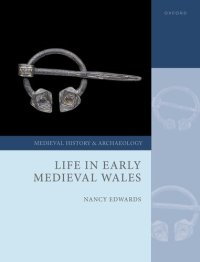
Ebook: Life in Early Medieval Wales
Author: Prof Nancy Edwards
- Series: Medieval History and Archaeology
- Year: 2023
- Publisher: Oxford University Press
- Language: English
- epub
Research for and the writing of this book was funded by the award of a Leverhulme Trust Major Research Fellowship.
The period c. AD300--1050, spanning the collapse of Roman rule to the coming of the Normans, was formative in the development of Wales. Life in Early Medieval Wales considers how people lived in late Roman and early medieval Wales, and how their lives and communities changed over the course of this period. It uses a multidisciplinary approach, focusing on the growing body of archaeological evidence set alongside the early medieval written sources together with place-names and personal names. It begins by analysing earlier research and the range of sources, the significance of the environment and climate change, and ways of calculating time. Discussion of the fourth, fifth, and sixth centuries focuses on the disintegration of the Roman market economy, fragmentation of power, and the emergence of new kingdoms and elites alongside evidence for changing identities, as well as important threads of continuity, notably Latin literacy, Christianity, and the continuation of small-scale farming
communities. Early medieval Wales was an entirely rural society. Analysis of the settlement archaeology includes key sites such as hillforts, including Dinas Powys, the royal crannog at Llangorse, and the Viking Age and earlier estate centre at Llanbedrgoch alongside the development, from the seventh century onwards, of new farming and other rural settlements. Consideration is given to changes in the mixed farming economy reflecting climate deterioration and a need for food security, as well as craft working and the roles of exchange, display, and trade reflecting changing outside contacts. At the same time cemeteries and inscribed stones, stone sculpture and early church sites chart the course of conversion to Christianity, the rise of monasticism, and the increasing power of the Church. Finally, discussion of power and authority analyses emerging evidence for sites of assembly, the rise of Mercia, and increasing English infiltration, together with the significance of Offa's and Wat's
Dykes, and the Viking impact. Throughout the evidence is placed within a wider context enabling comparison with other parts of Britain and Ireland and, where appropriate, with other parts of Europe to see broader trends, including the impacts of climate, economic, and religious change.
The period c. AD300--1050, spanning the collapse of Roman rule to the coming of the Normans, was formative in the development of Wales. Life in Early Medieval Wales considers how people lived in late Roman and early medieval Wales, and how their lives and communities changed over the course of this period. It uses a multidisciplinary approach, focusing on the growing body of archaeological evidence set alongside the early medieval written sources together with place-names and personal names. It begins by analysing earlier research and the range of sources, the significance of the environment and climate change, and ways of calculating time. Discussion of the fourth, fifth, and sixth centuries focuses on the disintegration of the Roman market economy, fragmentation of power, and the emergence of new kingdoms and elites alongside evidence for changing identities, as well as important threads of continuity, notably Latin literacy, Christianity, and the continuation of small-scale farming
communities. Early medieval Wales was an entirely rural society. Analysis of the settlement archaeology includes key sites such as hillforts, including Dinas Powys, the royal crannog at Llangorse, and the Viking Age and earlier estate centre at Llanbedrgoch alongside the development, from the seventh century onwards, of new farming and other rural settlements. Consideration is given to changes in the mixed farming economy reflecting climate deterioration and a need for food security, as well as craft working and the roles of exchange, display, and trade reflecting changing outside contacts. At the same time cemeteries and inscribed stones, stone sculpture and early church sites chart the course of conversion to Christianity, the rise of monasticism, and the increasing power of the Church. Finally, discussion of power and authority analyses emerging evidence for sites of assembly, the rise of Mercia, and increasing English infiltration, together with the significance of Offa's and Wat's
Dykes, and the Viking impact. Throughout the evidence is placed within a wider context enabling comparison with other parts of Britain and Ireland and, where appropriate, with other parts of Europe to see broader trends, including the impacts of climate, economic, and religious change.
Download the book Life in Early Medieval Wales for free or read online
Continue reading on any device:

Last viewed books
Related books
{related-news}
Comments (0)